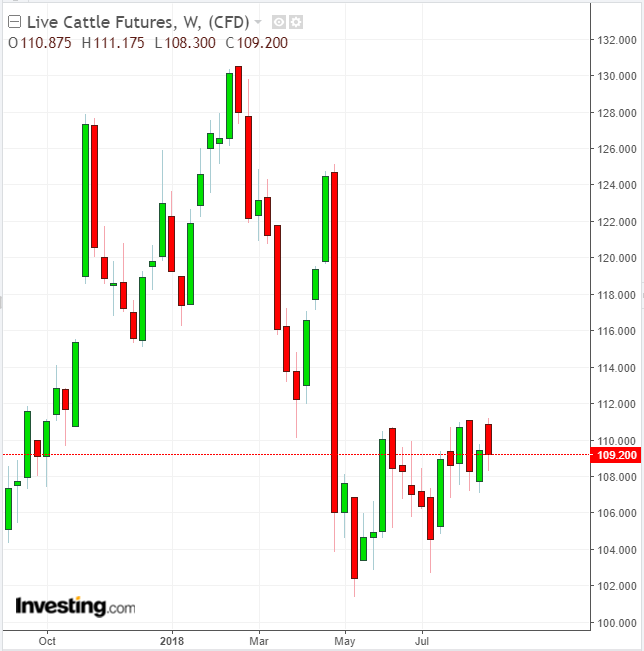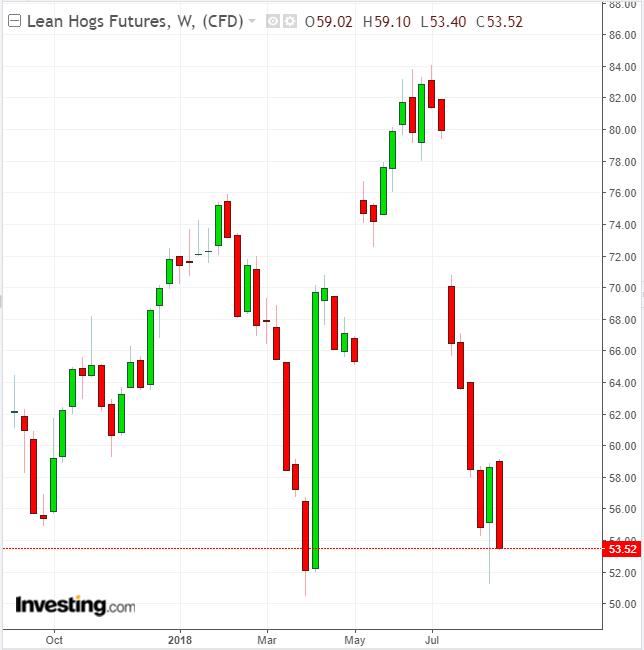Live cattle and lean hogs have both had some of the most volatile moves in US commodity markets this year. Each started firm, then either rocketed or plummeted against expectations, driven by shifting supply situations.

If their fates remain intertwined, then live cattle futures may see a powerful rally through 2019 from the increased demand—and potentially surging prices—eventually expected for lean hogs as the African swine fever (AFN) takes its toll on the pig population in China, the world’s largest pork consumer.

“Both the cattle and hog markets have been seeing very bullish smart money buying patterns that have triggered buy signals despite massive increased US supplies, a stronger dollar and trade war anxieties,” Shawn Hackett of Boca Raton, Florida-based agricultural markets consultancy Hackett Financial Advisors, said in a note on Monday. He acknowledged the intermittent volatility in both markets, as some investors sought clearer fundamentals to justify higher prices for the two meats.
“Well, that moment of clarity has, in fact, just taken place in the hog market,” Hackett wrote in his Monday note, referring to the second case of AFN outbreak in a province in China, which resulted in the culling of some 20,000 pigs in the country by Tuesday. In an interview with Investing.com on Wednesday, Hackett said China’s pork supplies will be immensely stretched if the epidemic wasn’t contained, resulting in importers there having to pull in US supplies, regardless of the 70 percent tax imposed by Beijing on US-pork amid its trade war with Washington. That would, conversely, tighten American hog supplies, resulting in the domestic search for alternative meats.
“If the AFN crisis really were to proliferate across China, they’d be counting heavily on imports to replace the pork they are losing. For the US, this means you have to start looking at beef primarily as your alternative protein source, a phenomenon that is going to drive the cattle market higher,” Hackett said.
Herd Replacements Faltering
However, cattle may not entirely be able to keep up with that demand as it has a longer-term reproductive cycle of two years, compared to hogs’ six months, he added.
“We are seeing signs of herd replacements in cattle beginning to falter. That usually leads to a slowdown in supply growth the following year. And this could happen in a year when supply in global meats has already been made tight by the swine fever afflicting pigs.”
As of Wednesday, live cattle futures on the Chicago Mercantile Exchange showed a market on the cusp of recovery. Week-to-date, prices were down 0.2 percent. For August, they were up 1.4 percent, while for the year they showed an 11 percent decline.
On Investing.com’s daily technicals, cattle was rated a “Strong Buy.” The October delivery contract for cattle, which settled on Wednesday’s at $1.09200 per pound, was only deemed a sell when it hit the 200-day moving average of $1.15282.
US lean hogs were, meanwhile, a “Strong Sell”, same as last week, with investors ignoring the AFN crisis in China and holding out instead for signs of a breakthrough in trade talks this week between China’s vice minister for commerce Wang Shouwen and US Treasury undersecretary David Malpass.
Tight Trading Range Vs. Strong Demand Trends
ADM Investor Services said in a note on Wednesday that live cattle trades in “a fairly tight range as negative supply news is offset by very strong demand trends.”
“Beef prices have moved higher over the last week and short-term supply is not too burdensome. This opens the door for a steady/firm cash market this week,” ADM added.
But Andrew Griffith, Assistant Professor of Agricultural and Resource Economics at the University of Tennessee, said in a comment this week that retail prices of beef generally lag cattle prices and were not necessarily the best measure of demand for live cattle.
“Demand for feeder cattle and calves remained strong this week with several active buyers,” Griffith said. “Many cattle producers in Tennessee and across the nation will soon be setting wheels under spring born calves as the fall marketing run will be in full swing from September through November, which means the market will be flush with cattle.”
Notwithstanding China’s AFN outbreak, most of the fundamental information available on cattle now, including fed cattle prices, calf numbers, reduced forage availability in many areas, and traditional marketing patterns suggests lower calf prices this fall, said Griffith. But, he added, one aspect supportive to prices was the expectation for a strong corn yield, “which should keep feed prices low.”
